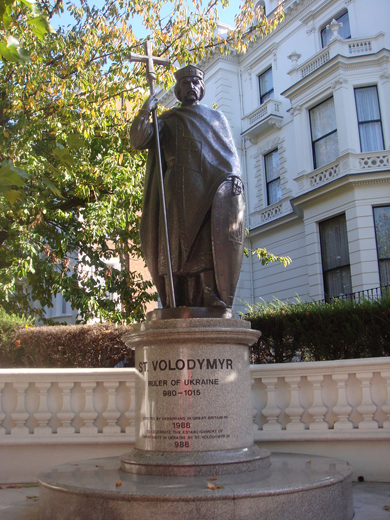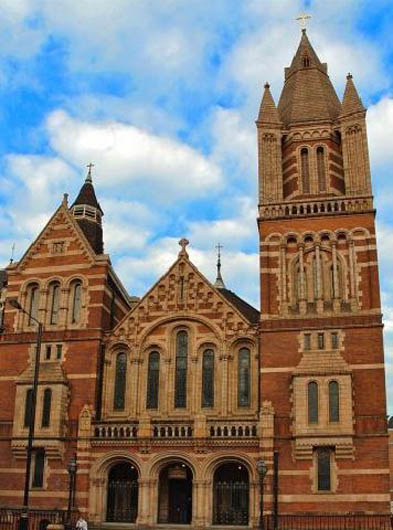London
London. See Map. The capital of Great Britain (2018 pop 8,961,989), situated on the Thames River in southeastern England. It has an active port and is one of the world’s leading financial, trading, industrial, and cultural centers. Concerted Ukrainian presence in London begins on the eve of the First World War. In 1912–15 George Raffalovich (pseudonym Bedwin Sands), a naturalized Briton of French and Jewish (from Odesa) background, published valuable materials there about Ukrainian affairs and advocated Ukraine’s independence. In 1919–23 the diplomatic missions of the governments of the Western Ukrainian National Republic and Ukrainian National Republic existed in London and were staffed by Arnold Margolin, Yaroslav Olesnytsky, Mykola Stakhovsky, M. Vishnitser, and Stepan Vytvytsky. In 1931–40 Yakiv Makohin sponsored the Ukrainian Bureau in London; its director was Vladimir Kaye-Kysilewsky until 1938–9, when it was headed by the Ukrainian Canadian S. Davidovich. In 1932–4 a hetmanite group led by Volodymyr Korostovets published a bulletin, the Investigator, in London. In 1933–5 Yevhen Liakhovych served as the Organization of Ukrainian Nationalists’ representative in the city.
During the interwar period there was a growing interest in Ukrainian issues among Britons. The Slavonic Review, whose contributors included Mykola Andrusiak, Elie Borschak, Dmytro Doroshenko, Isaak Mazepa, Ivan Mirchuk, Vasyl Paneiko, Roman Smal-Stotsky, Oleksander Shulhyn, and Avhustyn Voloshyn, provided a forum for the discussion of Ukrainian matters.
In 1935 the Anglo-Ukrainian Committee was established, with Lord Dickinson, Lord Noel-Buxton, several MPs, and the noted historians G. Gooch and R. Seton-Watson among its members. Other Londoners who involved themselves with Ukrainian affairs included the intelligence specialist Tracy Philipps, the lawyer and politician A. Lincoln, the businessman and politician C. Malone, and the publicist L. Lawton. After the Second World War the publicist Auberon Herbert, and a Catholic activist and editor of the weekly Tablet, D. Woodruff, were also sympathetic to Ukrainian concerns.
In August 1943 the Ukrainian Canadian Servicemen's Association moved its headquarters from Manchester to London. In 1945 it initiated the Central Ukrainian Relief Bureau. In August 1945 the Association of Ukrainian Soldiers in the Polish Armed Forces was established in London, and this organization enabled many Ukrainians, particularly those who had served in the Polish Second Corps under Władysław Anders, to begin settling in the city in 1946. In 1947 former members of the Division Galizien (approximately 8,500 men) were relocated from Italy and joined by many immigrants from the displaced persons camps in Germany.
In the early 1990s the Ukrainian community in London consisted of about 1,500 people. Initially they were predominantly factory and trade workers, but the second generation managed to establish itself in professions, such as law, medicine, teaching, journalism, and computer science.
The Ukrainian organizations in London include the Association of Ukrainians in Great Britain (SUB, est 1946), the Federation of Ukrainians in Great Britain (est 1949), the Anglo-Ukrainian Committee, the Mazepa Society, the Polish-Ukrainian Society, the Academic Society, the Students’ Hromada, the Ukrainian Graduates and Professional Association, the Ukrainian Press Agency, the Ukrainian Central Information Service, the Ukrainian Society, the Society of Ukrainian Litterateurs, the Association of Ukrainian Women in Great Britain, and the Ukrainian Former Combatants in Great Britain. There have been also branches of international organizations, such as the Ukrainian National Council, the Anti-Bolshevik Bloc of Nations, the Ukrainian Democratic Alliance (1970–1980s), the Ukrainian Helsinki Association, the Ukrainian Catholic University (Rome), the Saint Sophia Religious Society, the Plast Ukrainian Youth Association, and the Ukrainian Youth Association (SUM). The apostolic exarchate for Ukrainian Catholics in Great Britain and the eparchial administration of the Ukrainian Autocephalous Orthodox church have cathedrals in the city. The headquarters of most British Ukrainian organizations, a number of which have their own buildings, are in London.
Two publishing houses, Ukrainian Publishers Limited and Nashe Slovo, were active for some time. The weekly Ukraïns’ka dumka (London) (the organ of SUB), the monthlies Vyzvol’nyi shliakh, Soviet Nationality Survey, UGPA Newsletter, and Press Releases of the Ukrainian Press Agency, and the quarterlies The Ukrainian Review, Vidomosti Heneral'noho tserkovnoho upravlinnia UAPTs u Velykii Britaniï , and Surmach (a veterans’ publication) were all published in London. The Catholic quarterly Nasha tserkva was issued in 1953–75, and irregularly for a few years after that, before being replaced by the irregular Tserkovni visti.
The libraries of the British Museum and the London School of Slavonic and East European Studies have large holdings of valuable material concerning Ukraine and Ukrainians. (See also Great Britain.)
Constantine Zelenko
[This article originally appeared in the Encyclopedia of Ukraine, vol. 3 (1993).]


